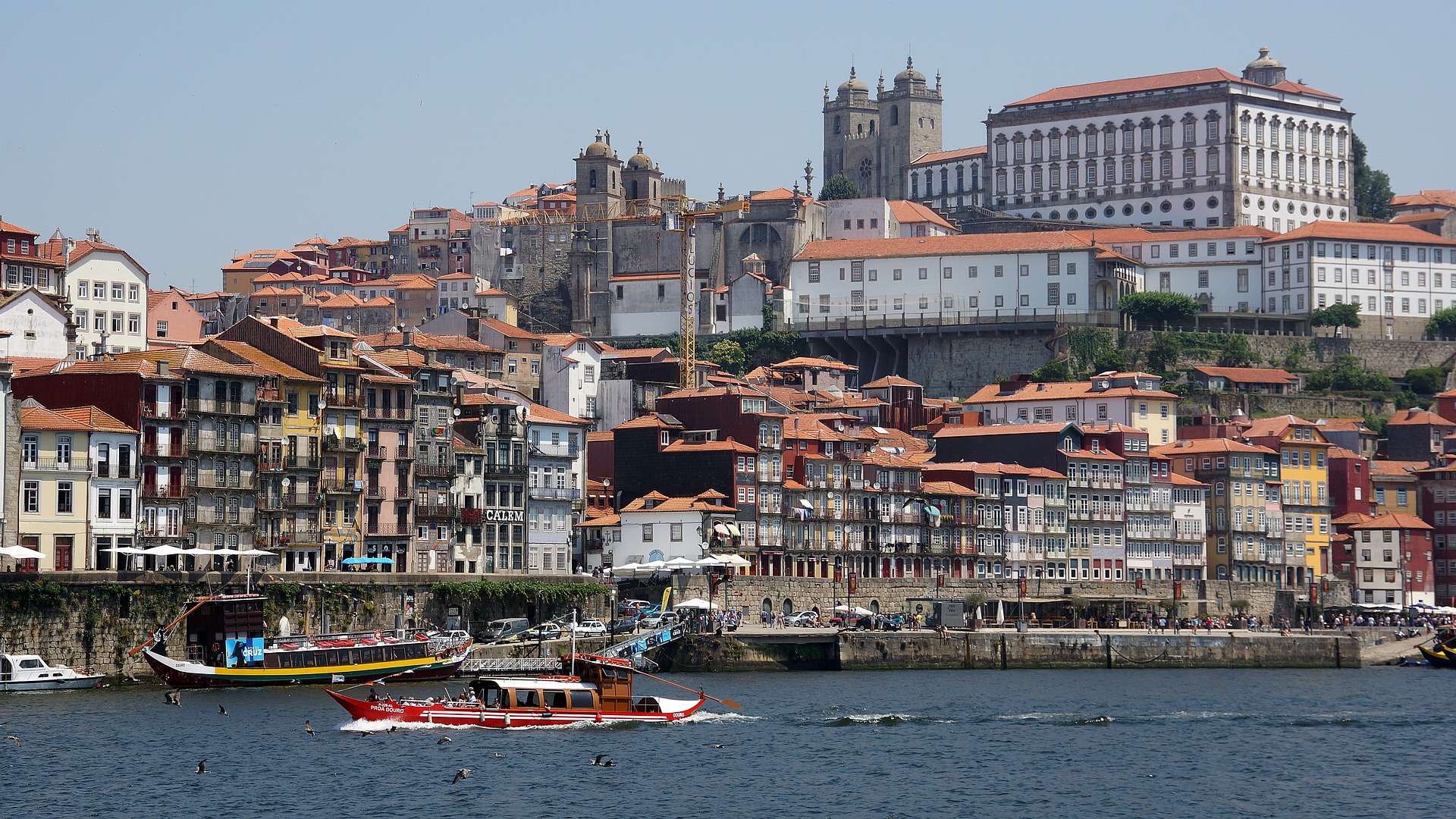Amarante has a secular occupation, once center of confluence for the roman roads, delimited by the Tâmega River and Serra do Marão, that also served, as a meal, substantial dishes to the weary travelers, fertilized and nourished the spirit of figures such as Teixeira de Pascoaes and Amadeo de Souza-Cardoso, and developed rich traditions based on the dichotomy, always present, between the religious and the profane.
But Amarante probably had its origin in the primitive civilizations that occupied the “Serra da Aboboreira”, although the exact name of its founders is unknown. But this quiet village only began to acquire importance and visibility after the arrival of Saint Gonçalo , in the 12th Century, although there is references that he was born in Guimarães but settled here after a pilgrimage through Rome and Jerusalem. As a tribute to this saint was build the old bridge over the River Tâmega. Amarante becomes a destination for pilgrimages, which has helped to increase population growth. In the 16th century, D. João III ordered the construction of the Monastery of São Gonçalo next to the bridge, where according to the tradition Saint Gonçalo lived and was buried.
At the beginning of the 19th century, Napoleon Bonaparte attempted to invade Portugal, passing through Amarante, being this village the stage for the heroic episode of the Defense of the Bridge of Amarante that resulted to General Silveira the title of Count of Amarante and the town of Amarante itself had the honor of be graced with the medal of the Military Order of the Tower and Sword, of Value, Loyalty and Merit that reflects in its municipal coat of arms.
Walk through the old streets, see the typical houses and the history that the city counts and don´t forget to delight yourself at some, but very good and local restaurants, where veal meat is one of the main attractions. For those who like to appreciate the old architecture, in Amarante, mainly in the historical center, there are numerous examples of the Romanesque and still many buildings of the Middle Ages.
It´s essential to visit the convent, and in the main square you will notice the sellers counters with the unique and traditional sweet of S. Gonçalo, because it looks phallic, and are always a source of curiosity and great laughter. The name of the sweet also helps … they are popularly called “quilhõezinhos de S. Gonçalo”. Tradition tells us that, at the S. Gonçalo festivities in June, the boys offers it to the girls they want to conquer. That was the way it used to be, but times changes. And according to the legend, anyone who wants to get engaged has to touch the tomb of S. Goncalo, since that he is considered the matchmaker.
AVEIRO
The name Aveiro originates due to the existence of numerous “webfooted” birds that populated this lagoon area. Its first name will have been Aviarium ( place of birds ).
Known as the Portuguese Venice, the charming city of Aveiro is crossed by a canal and is considered one of the most charming destinations in the country, thanks to its colourful moliceiros or gondolas, the buildings in pastel shades of Art and its quiet atmosphere Urban, an ideal setting for your holiday, and its natural lakes and lagoons. It captures the essence of a destination we would expect to see in a travel book.
While in town, visit the famous Fish Market, choose one of the traditional bakeries as you stroll through the city and taste the divine “ovos moles” ( soft eggs ), which are the specialty of the district. You can also stroll through the city’s sparkling canal, the picturesque alleyways and explore some of the city’s furthest attractions and discover Ílhavo, a seaside town that boasts the maritime heritage of Aveiro and where the famous porcelain factory of Vista Alegre is located. Also not to be missed, visit the oldest lighthouse of Portugal at Praia da Barra.
Aveiro, is a place like no other, have to experience it first hand to fully appreciate its magic.
BARCELOS
Originally a Roman settlement, it expanded and became the seat of the first Duke of Bragança ( or Condes de Barcelos ) in the 15th Century. The rooster or “ Galo “ in portuguese, is often used as a symbol of Portugal and it´s the town famous symbol, called as the “ Galo de Barcelos “, all due to a legend well known inside and outside of Portugal. One of the many versions of this legend narrates the miraculous intervention of a dead rooster in the proof of the innocence of a man mistakenly accused.
One day, the population of Barcelos were alarmed by a crime, of which the criminal who had committed it had not yet been discovered. On visit to the town, a pilgrim from Galizia region ( Spain ) appeared and became suspicious, so the authorities decided to arrest him, despite his oaths of innocence, which was only passing through on a pilgrimage to Santiago de Compostela, in fulfillment of a promise. Condemned to death, the man asked to be taken to the presence of the judge. Once the authorization was granted, they took him to the magistrate’s residence, which at that time was feasting with some friends. The pilgrim returned to affirm his innocence and, faced with the incredulity of those present, pointed to a roast rooster that was on the table and exclaimed:
“It is so certain that I am innocent, as it´s certain that this rooster crows when I´m hanged.”
The judge pushed the plate aside, laugh and ignored the appeal, but when the pilgrim was being hanged, the roast rooster stood on the table and sang. Understanding his mistake, the judge ran to the public square where the man was about to be executed and discovered that the pilgrim had been saved thanks to a bad knot. The man was immediately released and sent off in peace. A few years later, the pilgrim would have returned to Barcelos to sculpt the Monument of the Lord of the Rooster in praise of the Virgin Mary and the Greater Santiago, monument that now is possible to visit at the Archaeological Museum of Barcelos.
But besides roosters, who will certainly see a lot throughout the city (and of course, you can´t fail to bring at least one in the luggage), it is also a must stop to visit the main church of Santa Maria Maior, located in the center of the city; also visit the Paço of Condes de Barcelos, which was destroyed by the earthquake of 1755, but whose ruins are a living proof of the magnificence of this beautiful Palace of the 15th Century, which now also houses the Archeological Museum; and if you still have time visit the weekly fair, which is one of the most popular in the region, where color, life and activities are not lacking even for those who visit us.
Barcelos is the perfect combination of tradition, innovation and modernity. This beautiful city, shows of its best assets right from the streets, from where you can discover the history and art that have always been a present element of this location.
BRAGA
Braga is the third largest city of Portugal, so called the “Capital of Minho” region, or just the “Heart of Minho”. It is considered the youngest city in Europe due to the average age of the population being the lowest and simultaneously one of the oldest city in the world because it was built more than 2000 years ago, and “Bracara Augusta” as it was called, was founded precisely by Augusto, staying in one of the main Roman roads of the Iberian Peninsula, since it was the administrative headquarters of the Empire.
The Cathedral is also the oldest in the country and it was built in the 12th century, by the parents of the first king of Portugal. It is also worth visiting the Biscainhos Museum, housed in a baroque palace, the most outstanding period in the patrimony of Braga, or the D. Diogo de Sousa Archaeological Museum, since the city is also rich in vestiges of Roman times.
The Roman legacy is another of the attractive factors of Braga, often called ‘Portuguese Rome’. Walk through the historical center to visit some of the many churches, enjoy the historical houses and buildings such as the Palace of Lightning, Theatro Circo, the Arch of Porta Nova, or have a coffee in the emblematic Brazilian overlooking the bustle of Central Avenue. As one of the oldest Christian cities in the world, it has a vast religious heritage, and of its patrimony is evidenced the Sanctuary of Bom Jesus do Monte, one of the references of the European baroque.
To get to the Sanctuary of Bom Jesus you can go by foot, by car or take the funicular, but remember that the staircase leading to the top of the sanctuary, consists of 17 levels decorated with symbolic fountains, allegorical statues and other Baroque decoration dedicated to various religious themes and, at the top, the eight figures who participated in the Condemnation of Jesus. Not to be missed, the perspective at the bottom of the Staircase. Looking up, the fountains worked in granite at various levels stand out from the white forming a chalice, on which “the church” stands.
The ukuleles, violas, and Sacred art are also the ex-libris. Although these are the best known, Braga’s craft is more diverse: the linen items with loom production of a family of Braga, embroidery, wooden miniatures, “farricocos”, and the famous voltive candles made with all knowledge of several generations.
But please, don´t leave behind the rich gastronomy and wines, and a good example of that is in pastries and desserts that Braga’s cuisine is most original and refined, with the “Abade de Priscos” pudding, but the cod is considered as the favorite fish dish, the city is famous for its numerous cod recipes (Codfish à Narcisa, Codfish à Minhota). Also famous is the “sarrabulho” with pork meat, that you can combine with the perfect “vinho verde” (green wine).
Braga presents places that by their intrinsic devotion and beauty, impose themselves as mandatory benchmarks to visit. Visiting Braga is like taking a time travel inside modernity.
CHAVES
Chaves is a small town in the north of Portugal, only 10kms from the border with Spain. Located in the district of Vila Real, in a historical region called Tras-os-Montes.
The city was founded by the Romans as a spa town called Aquae Fluviae. Their impressive 2 millenium old bridge named after Emperor Trajan, with 16 arches and two milestones, remains over the Tâmega River, while their thermal springs (among the hottest in Europe), are still in use today, with warm waters that treat rheumatism and hypertension.
This old town is made up of narrow streets filled with elegant houses, which have carved wood balconies, being the Straight Street the most popular. At the main square, known as “Praça de Camões”, with a statue of the first Duke of Bragança standing in the center, is also one of the sites for relaxing and enjoying the typical commerce and where you can also visit the Parish Church (with a fine Romanesque portal) and the 17th century Baroque Misericordia Church.
Also in the same square is the Regional Museum devoted to archaeology, with prehistoric stones, Roman remains, and local crafts. Behind it, is the 14th century castle keep, the remains of an ancient castle that houses a Military Museum with displays of ancient weaponry and armour.
Chaves is surrounded by mountains and that brings windy and changing weather, so you’d better bring a jacket or an umbrella with you, at least in and autumn and winter.
GUIMARÃES
Guimarães of medieval origin, it has its roots in the remote 10th century. It was at this period, that the Countess Mumadona Dias, widow of Hermenegildo Mendes had a monastery built, which became a pole of attraction and gave birth to the settlement of a population group. But with the constant attacks by the Moors, she decided to build a fortress to protect the monks and the Christian communities.
The primitive Castle of Guimarães appears and in the 12th century, Count Henrique de Borgonha and Teresa de Leão came to live in the Castle of Guimarães and probably was there that our first King of Portugal was born, D. Afonso Henriques. Being the city that served as crib to the birth of Portugal, also known for “cradle of nationality”, it was from here that D. Afonso Henriques began the conquest of Portugal to the Moors, and still preserves a historical center that is Cultural Heritage of Humanity.
The “Vimaranenses”, as they are so called, are proudly treated by “Conquistadores” ( the conquerors) , fruit of this historical inheritance of conquest begun precisely in Guimarães. The historical center of the city, constitutes a unique vestige of a particular type of city conception, which had its own evolution, due to the morphology of its medieval urban fabric.
Important to visit the chapel of S. Miguel, where according to legend, here was baptized the first king of Portugal, where it saved the presumed baptismal font that was used in the cerimony. Near the Castle you can also visit the Palace of the Dukes of Bragança, a majestic 15th century house, built by D. Afonso, the first Duke of Bragança and the bastard son of King João I, who served as his residence and his second wife, D. Constancia of Noronha.
Walking through the streets of Guimarães, you will find the street of Santa Maria, it was one of the first open streets of the city and it was intended to be a link between the Santa Clara convent (now Guimarães Town Hall) and the Castle. Along the street you find several architectural testimonies of its past: Casa do Arco, Casa dos Peixoto, the Gothic House of Valadares de Carvalho, the House of the Carneiro that now houses the Municipal Library Raul Brandão, and many others that give a proper and characteristic identity to this city. At the end of this street, you may also find the square of Santiago, which is now a friendly place at any time of the day, very popular to the locals and those that visit us.
According to the legend, an image of the Virgin Mary was brought to Guimarães by the apostle Saint Tiago, and placed in a pagan temple in a square that was renamed St. Tiago’s Square. Also worth visiting, is the church of Our Lady Oliveira, built in 1387. Besides the Church, you will also see the Salado Pattern, a historical monument and unique in the country due to its shape and architecture. The history says that it recalls the victory of the King Afonso IV on the Moors, in 1340, in the battle of Salado.
Monte da Penha is the highest point of Guimarães and from its top, where a statue of Pope Pius IX is located, it is possible to reach magnificent views that can extend to the ocean.
Stop at the “The Citânia de Briteiros”, the impressive ruins of an important town inhabited in Protohistory, more than 2000 years ago, in an Era known by the archaeologists as Iron Age. It is one of the most expressive proto-historical settlements in the Iberian Peninsula.
The gastronomy Vimaranense aims to win the most demanding palates with the famous “Naco à Conquistador”. This old-fashioned but always current confection dish leaves anyone delighted with its veal meat, accompanied by products from the region, enhanced by the experienced hands of our farmers, integrating the true flavors of Vimaranenses.
LAMEGO
Ancient city, where they embrace several centuries, along squares and streets, crossing times, cultures and styles. Dating from the Romans time, it was definitively reconquered in 1057 by Fernando Magno de Leão to the Moors. It was here, in Lamego, that the legendary Cortes de Lamego took place, where the acclamation of King Afonso Henriques as King of Portugal was established and the “Rules of Succession to the Throne” were established.
It is the stage of the diocese of the District, and there are numerous religious monuments, such as the Cathedral, the Church of San Pedro de Balsemão and the Sanctuary of Our Lady of Remedios, which also gives the name to the annual Pilgrimage whose main day is the 8th of September, that is also the municipal holiday. Of the main places to visit, you have the Castle of Lamego, military architecture, Romanesque and Gothic, it was built on a mountain, adapting to the morphology of the ground.
Its very old fair and still very frequented by many people, reaching to tradesmen and fair Gypsy of Cordova (Spain), with its lively commerce in the New Street, also where once many Jews were established, building the Synagogue next to the “Portas do Sol”.
It is also known for its gastronomy, which highlights are its hams, “roast rabbit with rice in the oven” and the production of wines, namely Port wine, and the famous sparkling wines.
From these lands are born the most delicious apples and cherries and the olive with which one makes olive oil of recognized quality throughout the country. But it´s the vine that dominates the landscape and it was from the wine that the populations withdrew their main sustenance for centuries.
PESO DA RÉGUA
The origin of the foundation of Régua dates back to the Roman times. Here, the Romans will have installed in a “presidium”, making, by virtue of that, the territory communicable with other lands.
The first references to Régua as a village date from 1687, transcribed from one attribut by King Pedro II, for the holding of a fair. However, some historian writers assume that the foundation of Peso da Régua dates from the reign of D. Sancho I, although officially it was by King Manuel I that was assigned the first Foral in 1513.
Marquês de Pombal, our Minister in the 18th Century, created the first regulated region of the world in order to delimit the vineyards of the Douro Valley with granite landmarks, determining the production areas of the best wines. This was the prelude to the great odyssey of Douro wine, with the consequent settlement of the populations on the banks of the river. Men and women who continue to give their best to this land.
PINHÃO
Pinhão is a small village located in a bend of the River Douro, being the center of the wine region of Porto and the place where several farms are well known for producing generous wine. Its landscape is classified by UNESCO as the cultural heritage of humanity and the logical first port of call is the giant river bridge which you have to cross to get into the village. Its two arches make it a nice eyecatcher, particular with the hills in the back. Pinhão’s second sight is, curiously, its railway station.
No matter where you go in Portugal, you will come across so-called azulejos, painted tiles that either have a nice pattern or display pictures. Pinhão’s railway station has the total of 24 pannels of tiles, and all of them show scenes from the countryside around the village or scenes of the local people harvesting.
It was the first village of Vila Real District to have telephone and piped water.
While visiting the local wine producers, along the Douro valley, let your eyes enjoy the landscape, where the beauty of the river marries the geometry of the terraces supporting the vineyards.
PONTE DE LIMA
In the heart of the Lima Valley, the unique and beautiful beauty of the oldest village in Portugal hides deep roots and ancestral legends, leaving in memory of those who visits it a bitter sweet that one wants more.
To get to know it, you don´t have to stay for many days, but it is certainly one of the mandatory stops on your visit to the North. Its tranquility and natural beauty, as well as its many gastronomical experiences ( so traditional and distinct from our North), leaves without a shadow of doubt many nostalgic feelings, but more important of all is its religious importance, where Ponte de Lima is since always, one of the main points of passage in the “ Camiños de Santiago”… so do not be surprised if you meet one (or more) pilgrims on the way.
Between stops to visit the Main Church of the village, or enjoy a break in the “Largo de Camões” or Camões Square to be more precisely (homage to our great poet of the 16th Century); and visit the famous towers, the result of a medieval construction from the 14th Century, where our King Pedro I, attending to the geo-strategic position of Ponte de Lima, ordered to build a wall surrounded by nine towers, but only 2 remains visible; don´t forget to taste the richest delights of the region, from the famous and traditional cod as the main dish of any restaurant table, but also to the eel as a gastronomic postcard, always well accompanied by a good “malga” of “ Vinho Verde” ( green wine ), which can be either red or white!
PORTO
The best known Portuguese wine in the world, Port (a fortified wine), takes its name from the city of Porto. Also known as OPorto, the city is marked by centuries of history and also by industrial development.
To walk along the urban wine trail, head to the waterfront, you will be stunned with the amazing alleys, the small streets fill with traditions and charms, where a rich architectural mix leaves the idea of the historical value of this city.
The center, located in Ribeira, was built in the hills in front of the Douro River. Today, the site is a UNESCO World Heritage Site. The 14th century San Francisco Church is one of the main attractions, but not the only one, as are the local port wine cellars. The Lello Library, home of men of letters and the arts, an inspiration for famous writers, the stage for gatherings and shows, was founded in 1906 and cannot be missed.
Then you can also visit the Clérigos Tower, the Cathedral, or simply stroll along the Avenue of the Aliados, flanked by a line of Art Nouveau and Art Deco façades. But, more important of all, don´t forget to try the “ francesinha”, meaning Little Frenchie, is a Portuguese sandwich originally from Porto, made with bread, wet-cured ham, linguiça, fresh sausage, steak and covered with melted cheese and a hot thick tomato and beer sauce served with french fries; or even the “ Tripas à moda do Porto”, a traditional dish and which, according to a legend, dates back to the Portuguese Discoveries. Is made with various types of meat, casings, sausages and white beans and this dish was one of the finalists to the 7 Wonders of Portuguese Gastronomy. More importantly, always accompanied with a good wine…
VIANA DO CASTELO
Viana do Castelo is the northernmost Atlantic city in Portugal, and is known as the “Princess of Lima”. The unparalleled wealth of Vianese ethnography, that also makes the city the capital of Portuguese folklore. The origins of Viana do Castelo date back to the Iron Age, as evidenced by the ancient pre-Roman city erected at that time on Mount Santa Luzia. But its history, always linked to the sea, describes a set of events that made Viana one of the main commercial ports of the country.
In 1258, King Afonso III, named it Viana da Foz do Lima, anticipating its maritime vocation. Later, in the 19th Century and by decree of our Queen Maria II, Viana is elevated to the rank of city and adopted the name that it is known by nowadays: Viana do Castelo.
The República Square is, for five hundred years, the civic center of Viana do Castelo and the buildings of the rising top are an emblematic monumental triptych of high architectural value: the elegant fountain, the Misericordy Church building and the Old Town Hall, whose construction took place in the first half of the 16th century.
The city, so rich in traditions, and its famous costume, as a true national symbol of Portugal is recognized abroad thanks to the colour and originality of its parts. The goldsmiths craftsmanship of Viana is also reflecting faithfully its traditions. Earrings, chains and other loops of the Queen ( Rainha ), gold braided and elaborate gold filigree wire are an integral part of the name of the city, intimately linked to the costume of Viana and its image.
The gastronomy and the environmental heritage make Viana do Castelo a tourist destination that offers those who visit it vast grounds of enchantment and provides the palate with exquisite and substantiated pleasures. Viana do Castelo has always been linked to the faithful friend, cod. From here they set sail for Newfoundland and Greenland, the “bacalhoeiros” loaded with faith and hope in a good job.
There they stayed for six months, after which they returned to their lands. And the cod settled gastronomically, in this county, making of it the center of all the attention of the faithful gourmets to a good “bacalhoada”. As a living proof of this heritage, is a must stop to visit the Gil Eanes Ship-Hospital, built in 1955, and that nowadays works as a Museum. But more important than anything, regardless of the season when you decide to visit us, enjoy the 24km along its coastline, beaches rich in natural beauty, where the climate usually presents us with rather mild and mild days.
VILA NOVA DE FÔZ COA
In its roots, Vila Nova de Foz Côa, or simply Foz Côa, leads us to meet with the Paleolithic man who, with his modest artifacts, in the hardness of the schist he honored his ambitions and projects of his spiritual and material universe, making this sanctuary the largest open art museum cave, now World Heritage Site. It´s a unique example of Man’s first creations of symbolic expression and the beginning of culture.
Located in the Guarda region in Northern Portugal and has little more than 7 thousand inhabitants, with a road surrounded of natural beauty, and where you can see the most typical regional goods, like olive trees and vineyards. Foz Côa also has some interesting monuments considered of National importance, like for example the Numão Castle; the city’s Pelourinho and the main Church. And, more important of all, you must visit the Côa Museum and the Archaeological Park, where you can learn all about the Paleolithic and its secrets and explore paintings on the rocks with more than 25.000 years.
The handicraft, if it once had a marked role in the daily life of these people, is now almost extinct, and there are nothing but memories of the pottery, spinning and bordery. It is recommended to visit the nucleus of Ethnography in the Museum of the Great House of Freixo de Numão.
If you can, make a visit between February and March, when it’s the season of the blossom of the almond trees! The region gets very colorful with the white and pink of the flowers. And don’t forget to enjoy the local olive oil and wines, of course!
VILA REAL
Situated at the foothills of the majestic slopes of Serra do Marão ( a mountain where it often snows in winter ), Vila real is a small, lively city and Capital of Trás-os-Montes province. Founded by King Dinis in 1289, this beautiful city played an important role in the history of Portugal. It was the birthplace of Diogo Cão, the first explorer to reach the Congo river.
Also it was the residence for many aristocrats that had build here grand Palaces, during the 16th and 17th Centuries, that well preserves stately houses adorned with coats of arms, Manueline windows and traditional wrought iron balconies. Vila Real is an ideal base for exploring the Douro river valley and following the famous Port Wine Route, not forgetting the its typical pastries, such as “Cristas d galo”, “Cavacórios”, or simply enjoying a meal of excellence, where you will find as base ingredient products of the region, such as lamb, veel, wild rabbit or the traditional cod.
Traces of earlier settlements, such as the Sanctuary of Panóias, reveal the Roman presence, and that’s definitely one of the sites you must see. Other buildings of interest in Vila Real includes a 15th century Gothic Cathedral, once part of a Dominican monastery, the Baroque Saint Pedro Church, with its ceiling of carved and gilded wood and the Baroque “Capela Nova”, also attributed to Nicola Nasoni, which features 18th century tiles ( azulejos ).
Also visit the famous Mateus Palace, built in 1745 and used as a holiday home by the Portuguese royal family, which is featured on bottles of well-known Mateus rose wine.
The “Olaria Negra de Bisalhães” is one of the ex-libris of Vila Real, declared an Intangible Cultural Heritage by Unesco, rich in its secular tradition that continues to this day. The clay is chopped until it is discarded in powder, the impurities are removed, then the Potter gives form to the wheel, and before the piece dries, flowers and other ornaments are drawn. Baking is done in an open oven on the floor. It´s essential to visit the village of Bisalhães, where some potters still work, although it is a profession in danger of extinction.





